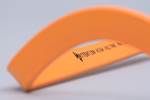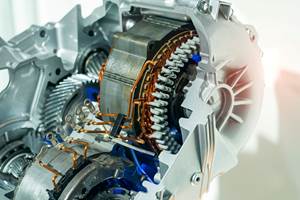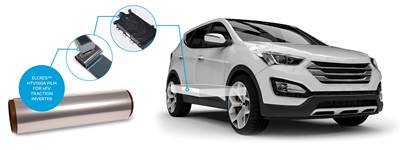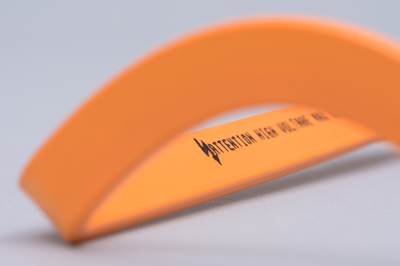Getting Charged Up About Electric Vehicles
Metal-to-plastics replacement stories are a classic of the genre for plastics publishing, and nowhere more so than in the automotive space.
Share
Read Next
Metal-to-plastics replacement stories are a classic of the genre for plastics publishing, and nowhere more so than in the automotive space. Encroaching on metals in all facets from from the interior to the exterior and improving aesthetics and functionality, plastics in many ways became the material of choice for OEMs, particularly as they helped vehicles shed weight and gain mileage. The final frontier for plastics in automotive was under the hood and in the engine compartment. Here, advances in engineering plastics that granted the materials heat and chemical resistance, allowed plastics to take up space in the very heart of the car—the internal combustion engine (ICE).
Today as battery electric vehicles (BEV) gain traction, plastics, metals, rubber and glass are all vying to claim space in traditional automotive components and wholly new ones as batteries replace engines as the heart of the vehicle. With these sweeping changes in mind, injection molding machine and automation supplier, Engel, and materials supplier Sabic, organized an event in early June in Novi, Mich. that asked three key questions: when will electric mobility become established; what are the opportunities for plastics; and can they be the leading material for future battery concepts. The answers to those questions provided by speakers hailing from OEMs, Tier Ones, and material and machinery suppliers were sooner than you might think; bountiful; and most definitely.
Kevin Riddell, senior manager of power train forecasts, LMC Automotive told attendees that while sales of traditional ICE vehicles were down 10%, due in part to new—war in Ukraine—and old—Coronavirus shutdowns—supply chain headaches, BEV sales were up 84% and even reached 10% market share in a couple months for the first time ever. Year-to-date, Riddell said BEV sales were up 61% in the U.S., which is seeing consistent, steady growth. In Europe, Riddell said BEVs are “taking off,” up 48% in the last few months, while in China BEVs are seeing “incredible growth”, per Riddell, up 107%. Responding to the growth and the potential in the U.S., Riddell said that by the end of 2030, there will be 20 OEMs making BEVs in North America.
Charging Forward
Hinrich Woebckn of Blue Lagoon Capital, who started his professional life in injection molding, moved beyond numbers in his assessment of the broader market adoption of BEVs. “It's done, the world will change,” Woebckn said. “It's not a question of how many percent, pessimist view, optimist view. The car makers cannot afford to serve two ecosystems over a long period. It's tearing them apart. There is no chance OEMs will stay profitable if they try to serve two power train systems.”
Dhanendra Nagwanshi of SABIC addressed the myriad opportunities for plastics in automotive’s newest component: the battery. “Steel and aluminum were used initially to make battery housings,” Nagwanshi said. “Now, we can see how plastics are an option that can reduce weight, improve performance and enhance safety.”
In battery applications, fire safety is a critical requirement, and Nagwanshi said it is driving demand for next generation flame retardant materials. To make the housings, which are quite large and must exhibit no warparge, OEMs are looking at thermoforming (and by extension sheet extrusion), low pressure injection molding and compression molding.
Sabic has developed a plastic intensive design that it says can provide 30-50% weight savings versus aluminum and offer increased functionality. Regarding flame retardance, the housings have to satisfy a thermal runaway test, which involves exposing the material to 1100C for 5-and-a-half minutes. Sabic utilized a polypropylene (PP) with flame retardant. Under flame, the PP chars and forms an intumescent layer. Under the same conditions, aluminum develops a hole, while for the plastic, the non exposed side registers a temperature of less than 200 C. Sabic is researching low-pressure injection molding on machines ranging from 2500 to 3500 tons. The parts are relatively complex, featuring ribs and requiring warpage correction capabilities. Structural foam is also being considered. Sabic has real world experience on this front, with a plastics battery cover that measures 1 m wide and 1.6 m long in production for Honda. That particular part won an award from SPE’s automotive division.
All in One Mold
Michael Fischer, head of business development automotive technologies for Engel, laid out another opportunity area for plastics in BEV—the front panel. The company undertook a front-panel design project, starting back in 2018. The goal was to create a molded component that could be decorated and also be Lidar and radar transparent, acknowledging the increasing number of sensors going into vehicles. To protect the surface, a polyurethane (PUR) layer is utilized. Finally, Engel wanted all this in a one-step process. In the final part, the PUR layer is 3 mm, with an in-mold decoration measuring 0.02 mm thick, and a molded polycarbonate (PC) substrate of 3.5 mm. The company achieved all this on a duo 900 machine, with PUR dosing capabilities, a sliding table mold concept, a roll feeder for decoration, and Easix 6-axis automation. In the process, the sliding table mold moves from a to b, right to left. Film with a paint layer is rolled through the cavity and held in place by a clamping arm. Once cool, the mold opens; the right cavity moves in and the PUR mixing head is integrated. Right now in testing, Fischer said Engel has gotten the cycle down to 130 seconds—it was at 160.
The Iron Horse
Sandy Munro, leading industry consultant and founder of Munro & Associates, illustrated the sweeping changes to come by going back to a previous paradigm shift in transportation. Showing pictures of a city street in 1900 and 1913, he asked the audience to try to spot the car in the first image amidst a sea of horses, and then, just over a decade later, try to locate the lone horse among the street full of cars.
“I think the switch from ICE to EVs will happen a lot faster,” Munro said. “Don't just talk to 35 year old’s; talk to 9 and 12 year old’s. I predict that by 2028, production will be split 50:50 between EVs and ICE. That's when 9 and 12 yr old’s be driving.” Munro no longer does any project work with ICE vehicles. “The data against ICE is phenomenal,” Munro said, adding, “ask kids what they think of gasoline.”
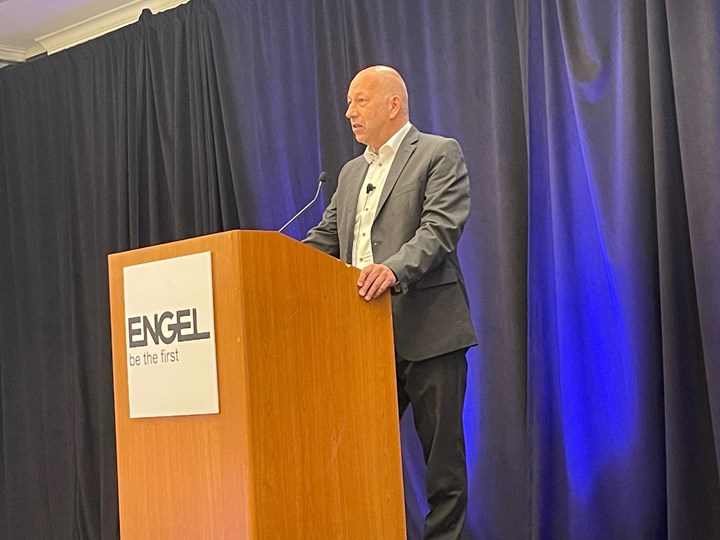
Engel’s Michael Fischer kicks off their automotive event organized with Sabic in Novi, Mich.
Related Content
SPE Automotive Awards Applaud ‘Firsts’ and Emerging Technologies
The 51st annual SPE Automotive Innovation awards gave nods to several ‘firsts’ and added alternative vehicle systems category.
Read MorePlastic Compounding Market to Outpace Metal & Alloy Market Growth
Study shows the plastic compounding process is being used to boost electrical properties and UV resistance while custom compounding is increasingly being used to achieve high-performance in plastic-based goods.
Read MoreMolder Repairs Platen Holes with Threaded Inserts
Automotive molder ITW Deltar Fasteners found new life for the battered bolt holes on its machine platens with a solution that’s designed to last.
Read MorePEEK for Monolayer E-Motor Magnet Wire Insulation
Solvay’s KetaSpire KT-857 PEEK extrusion compound eliminates adhesion and sustainability constraints of conventional PEEK or enamel insulation processes.
Read MoreRead Next
New Grades Target Electric Vehicles
SABIC says the two new glass-fiber-reinforced grades of Noryl bring enhanced flame retardancy and impact strength to battery modules and housings in electric vehicles (EV).
Read MoreThinner Gauge Dielectric Film for Capacitors of Hybrid, Plug-in-Hybrid, and Battery Electric Vehicles
SABIC’s new 3-micron gauge of Elcres HTV150A film is 40% thinner than its 5-micron film launched last year.
Read MoreNylon 12 Compound Boasts Highest Fire Protection for Busbars in High-Voltage Batteries of Electric Vehicles
Evonik’s new Vestamid LX9050 OR made with a halogen-fress flame retardant meets the requirements for classification V-0 of its flammability according to UL94.
Read More



